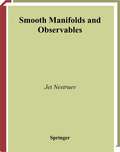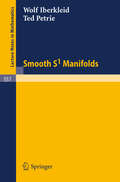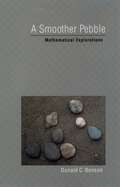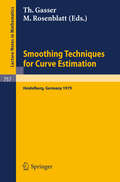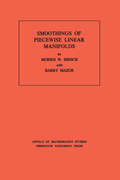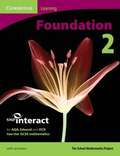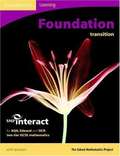- Table View
- List View
Smooth Manifolds and Fibre Bundles with Applications to Theoretical Physics
by Steinar JohannesenThis book provides a systematic presentation of the mathematical foundation of modern physics with applications particularly within classical mechanics and the theory of relativity. Written to be self-contained, this book provides complete and rigorous proofs of all the results presented within. Among the themes illustrated in the book are differentiable manifolds, differential forms, fiber bundles and differential geometry with non-trivial applications especially within the general theory of relativity. The emphasis is upon a systematic and logical construction of the mathematical foundations. It can be used as a textbook for a pure mathematics course in differential geometry, assuming the reader has a good understanding of basic analysis, linear algebra and point set topology. The book will also appeal to students of theoretical physics interested in the mathematical foundation of the theories.
Smooth Manifolds and Fibre Bundles with Applications to Theoretical Physics: An Introduction To Principles And Practice, Second Edition
by Steinar JohannesenThis book provides a systematic presentation of the mathematical foundation of modern physics with applications particularly within classical mechanics and the theory of relativity. Written to be self-contained, this book provides complete and rigorous proofs of all the results presented within. Among the themes illustrated in the book are differentiable manifolds, differential forms, fiber bundles and differential geometry with non-trivial applications especially within the general theory of relativity. The emphasis is upon a systematic and logical construction of the mathematical foundations. It can be used as a textbook for a pure mathematics course in differential geometry, assuming the reader has a good understanding of basic analysis, linear algebra and point set topology. The book will also appeal to students of theoretical physics interested in the mathematical foundation of the theories.
Smooth Manifolds and Observables (Graduate Texts in Mathematics #220)
by Jet NestruevThis book gives an introduction to fiber spaces and differential operators on smooth manifolds. Over the last 20 years, the authors developed an algebraic approach to the subject and they explain in this book why differential calculus on manifolds can be considered as an aspect of commutative algebra. This new approach is based on the fundamental notion of observable which is used by physicists and will further the understanding of the mathematics underlying quantum field theory.
Smooth Manifolds and Observables (Graduate Texts in Mathematics #220)
by Jet NestruevThis book gives an introduction to fiber spaces and differential operators on smooth manifolds. Over the last 20 years, the authors developed an algebraic approach to the subject and they explain in this book why differential calculus on manifolds can be considered as an aspect of commutative algebra. This new approach is based on the fundamental notion of observable which is used by physicists and will further the understanding of the mathematics underlying quantum field theory.
Smooth Nonlinear Optimization in Rn (Nonconvex Optimization and Its Applications #19)
by Tamás RapcsákExperience gained during a ten-year long involvement in modelling, program ming and application in nonlinear optimization helped me to arrive at the conclusion that in the interest of having successful applications and efficient software production, knowing the structure of the problem to be solved is in dispensable. This is the reason why I have chosen the field in question as the sphere of my research. Since in applications, mainly from among the nonconvex optimization models, the differentiable ones proved to be the most efficient in modelling, especially in solving them with computers, I started to deal with the structure of smooth optimization problems. The book, which is a result of more than a decade of research, can be equally useful for researchers and stu dents showing interest in the domain, since the elementary notions necessary for understanding the book constitute a part of the university curriculum. I in tended dealing with the key questions of optimization theory, which endeavour, obviously, cannot bear all the marks of completeness. What I consider the most crucial point is the uniform, differential geometric treatment of various questions, which provides the reader with opportunities for learning the structure in the wide range, within optimization problems. I am grateful to my family for affording me tranquil, productive circumstances. I express my gratitude to F.
Smooth Quasigroups and Loops (Mathematics and Its Applications #492)
by L. SabininDuring the last twenty-five years quite remarkable relations between nonas sociative algebra and differential geometry have been discovered in our work. Such exotic structures of algebra as quasigroups and loops were obtained from purely geometric structures such as affinely connected spaces. The notion ofodule was introduced as a fundamental algebraic invariant of differential geometry. For any space with an affine connection loopuscular, odular and geoodular structures (partial smooth algebras of a special kind) were introduced and studied. As it happened, the natural geoodular structure of an affinely connected space al lows us to reconstruct this space in a unique way. Moreover, any smooth ab stractly given geoodular structure generates in a unique manner an affinely con nected space with the natural geoodular structure isomorphic to the initial one. The above said means that any affinely connected (in particular, Riemannian) space can be treated as a purely algebraic structure equipped with smoothness. Numerous habitual geometric properties may be expressed in the language of geoodular structures by means of algebraic identities, etc.. Our treatment has led us to the purely algebraic concept of affinely connected (in particular, Riemannian) spaces; for example, one can consider a discrete, or, even, finite space with affine connection (in the form ofgeoodular structure) which can be used in the old problem of discrete space-time in relativity, essential for the quantum space-time theory.
Smooth Tests of Goodness of Fit (Oxford Statistical Science Series)
by J. C. Rayner D. J. BestGoodness of fit describes the validity of models involving statistical distributions of data, and smooth tests are a subset of these tests that are easy to apply and can be used in any situation in which there are relatively large sample sizes. Both concepts have become increasingly important with the advent of high-speed computers and the implementation of more complex models in the areas of probability and statistics. Written to be accessible to undergraduates with a knowledge of statistics and calculus, this is an introductory reference work that should appeal to all professionals involved in statistical modeling.
Smooth Tests of Goodness of Fit: Using R
by J. C. Rayner O. Thas D. J. BestIn this fully revised and expanded edition of Smooth Tests of Goodness of Fit, the latest powerful techniques for assessing statistical and probabilistic models using this proven class of procedures are presented in a practical and easily accessible manner. Emphasis is placed on modern developments such as data-driven tests, diagnostic properties, and model selection techniques. Applicable to most statistical distributions, the methodology described in this book is optimal for deriving tests of fit for new distributions and complex probabilistic models, and is a standard against which new procedures should be compared. New features of the second edition include: Expansion of the methodology to cover virtually any statistical distribution, including exponential families Discussion and application of data-driven smooth tests Techniques for the selection of the best model for the data, with a guide to acceptable alternatives Numerous new, revised, and expanded examples, generated using R code Smooth Tests of Goodness of Fit is an invaluable resource for all methodological researchers as well as graduate students undertaking goodness-of-fit, statistical, and probabilistic model assessment courses. Practitioners wishing to make an informed choice of goodness-of-fit test will also find this book an indispensible guide. Reviews of the first edition: "This book gives a very readable account of the smooth tests of goodness of fit. The book can be read by scientists having only an introductory knowledge of statistics. It contains a fairly extensive list of references; research will find it helpful for the further development of smooth tests." --T.K. Chandra, Zentralblatt für Mathematik und ihre Grenzgebiete, Band 73, 1/92' "An excellent job of showing how smooth tests (a class of goodness of fit tests) are generally and easily applicable in assessing the validity of models involving statistical distributions....Highly recommended for undergraduate and graduate libraries." --Choice "The book can be read by scientists having only an introductory knowledge of statistics. It contains a fairly extensive list of references; researchers will find it helpful for the further development of smooth tests."--Mathematical Reviews "Very rich in examples . . . Should find its way to the desks of many statisticians." --Technometrics
A Smoother Pebble: Mathematical Explorations
by Donald C. BensonThis book takes a novel look at the topics of school mathematics--arithmetic, geometry, algebra, and calculus. In this stroll on the mathematical seashore we hope to find, quoting Newton, "...a smoother pebble or a prettier shell than ordinary..." This book assembles a collection of mathematical pebbles that are important as well as beautiful.
Smoothing and Regression: Approaches, Computation, and Application (Wiley Series in Probability and Statistics #766)
by Michael G. SchimekA comprehensive introduction to a wide variety of univariate and multivariate smoothing techniques for regression Smoothing and Regression: Approaches, Computation, and Application bridges the many gaps that exist among competing univariate and multivariate smoothing techniques. It introduces, describes, and in some cases compares a large number of the latest and most advanced techniques for regression modeling. Unlike many other volumes on this topic, which are highly technical and specialized, this book discusses all methods in light of both computational efficiency and their applicability for real data analysis. Using examples of applications from the biosciences, environmental sciences, engineering, and economics, as well as medical research and marketing, this volume addresses the theory, computation, and application of each approach. A number of the techniques discussed, such as smoothing under shape restrictions or of dependent data, are presented for the first time in book form. Special features of this book include: * Comprehensive coverage of smoothing and regression with software hints and applications from a wide variety of disciplines * A unified, easy-to-follow format * Contributions from more than 25 leading researchers from around the world * More than 150 illustrations also covering new graphical techniques important for exploratory data analysis and visualization of high-dimensional problems * Extensive end-of-chapter references For professionals and aspiring professionals in statistics, applied mathematics, computer science, and econometrics, as well as for researchers in the applied and social sciences, Smoothing and Regression is a unique and important new resource destined to become one the most frequently consulted references in the field.
Smoothing and Regression: Approaches, Computation, and Application (Wiley Series in Probability and Statistics #766)
by Michael G. SchimekA comprehensive introduction to a wide variety of univariate and multivariate smoothing techniques for regression Smoothing and Regression: Approaches, Computation, and Application bridges the many gaps that exist among competing univariate and multivariate smoothing techniques. It introduces, describes, and in some cases compares a large number of the latest and most advanced techniques for regression modeling. Unlike many other volumes on this topic, which are highly technical and specialized, this book discusses all methods in light of both computational efficiency and their applicability for real data analysis. Using examples of applications from the biosciences, environmental sciences, engineering, and economics, as well as medical research and marketing, this volume addresses the theory, computation, and application of each approach. A number of the techniques discussed, such as smoothing under shape restrictions or of dependent data, are presented for the first time in book form. Special features of this book include: * Comprehensive coverage of smoothing and regression with software hints and applications from a wide variety of disciplines * A unified, easy-to-follow format * Contributions from more than 25 leading researchers from around the world * More than 150 illustrations also covering new graphical techniques important for exploratory data analysis and visualization of high-dimensional problems * Extensive end-of-chapter references For professionals and aspiring professionals in statistics, applied mathematics, computer science, and econometrics, as well as for researchers in the applied and social sciences, Smoothing and Regression is a unique and important new resource destined to become one the most frequently consulted references in the field.
Smoothing Methods in Statistics (Springer Series in Statistics)
by Jeffrey S. SimonoffFocussing on applications, this book covers a very broad range, including simple and complex univariate and multivariate density estimation, nonparametric regression estimation, categorical data smoothing, and applications of smoothing to other areas of statistics. It will thus be of particular interest to data analysts, as arguments generally proceed from actual data rather than statistical theory, while the "Background Material" sections will interest statisticians studying the field. Over 750 references allow researchers to find the original sources for more details, and the "Computational Issues" sections provide sources for statistical software that use the methods discussed. Each chapter includes exercises with a heavily computational focus based upon the data sets used in the book, making it equally suitable as a textbook for a course in smoothing.
Smoothing of Multivariate Data: Density Estimation and Visualization (Wiley Series in Probability and Statistics #737)
by Jussi Sakari KlemeläAn applied treatment of the key methods and state-of-the-art tools for visualizing and understanding statistical data Smoothing of Multivariate Data provides an illustrative and hands-on approach to the multivariate aspects of density estimation, emphasizing the use of visualization tools. Rather than outlining the theoretical concepts of classification and regression, this book focuses on the procedures for estimating a multivariate distribution via smoothing. The author first provides an introduction to various visualization tools that can be used to construct representations of multivariate functions, sets, data, and scales of multivariate density estimates. Next, readers are presented with an extensive review of the basic mathematical tools that are needed to asymptotically analyze the behavior of multivariate density estimators, with coverage of density classes, lower bounds, empirical processes, and manipulation of density estimates. The book concludes with an extensive toolbox of multivariate density estimators, including anisotropic kernel estimators, minimization estimators, multivariate adaptive histograms, and wavelet estimators. A completely interactive experience is encouraged, as all examples and figurescan be easily replicated using the R software package, and every chapter concludes with numerous exercises that allow readers to test their understanding of the presented techniques. The R software is freely available on the book's related Web site along with "Code" sections for each chapter that provide short instructions for working in the R environment. Combining mathematical analysis with practical implementations, Smoothing of Multivariate Data is an excellent book for courses in multivariate analysis, data analysis, and nonparametric statistics at the upper-undergraduate and graduatelevels. It also serves as a valuable reference for practitioners and researchers in the fields of statistics, computer science, economics, and engineering.
Smoothing Spline ANOVA Models (Springer Series in Statistics)
by Chong GuSmoothing methods are an active area of research. In this book, the author presents a comprehensive treatment of penalty smoothing under a unified framework. Methods are developed for (i) regression with Gaussian and non-Gaussian responses as well as with censored life time data; (ii) density and conditional density estimation under a variety of sampling schemes; and (iii) hazard rate estimation with censored life time data and covariates. Extensive discussions are devoted to model construction, smoothing parameter selection, computation, and asymptotic convergence. Most of the computational and data analytical tools discussed in the book are implemented in R, an open-source clone of the popular S/S- PLUS language.
Smoothing Spline ANOVA Models (Springer Series in Statistics #297)
by Chong GuNonparametric function estimation with stochastic data, otherwiseknown as smoothing, has been studied by several generations ofstatisticians. Assisted by the ample computing power in today'sservers, desktops, and laptops, smoothing methods have been findingtheir ways into everyday data analysis by practitioners. While scoresof methods have proved successful for univariate smoothing, onespractical in multivariate settings number far less. Smoothing splineANOVA models are a versatile family of smoothing methods derivedthrough roughness penalties, that are suitable for both univariate andmultivariate problems.In this book, the author presents a treatise on penalty smoothingunder a unified framework. Methods are developed for (i) regressionwith Gaussian and non-Gaussian responses as well as with censored lifetime data; (ii) density and conditional density estimation under avariety of sampling schemes; and (iii) hazard rate estimation withcensored life time data and covariates. The unifying themes are thegeneral penalized likelihood method and the construction ofmultivariate models with built-in ANOVA decompositions. Extensivediscussions are devoted to model construction, smoothing parameterselection, computation, and asymptotic convergence.Most of the computational and data analytical tools discussed in thebook are implemented in R, an open-source platform for statisticalcomputing and graphics. Suites of functions are embodied in the Rpackage gss, and are illustrated throughout the book using simulatedand real data examples.This monograph will be useful as a reference work for researchers intheoretical and applied statistics as well as for those in otherrelated disciplines. It can also be used as a text for graduate levelcourses on the subject. Most of the materials are accessible to asecond year graduate student with a good training in calculus andlinear algebra and working knowledge in basic statistical inferencessuch as linear models and maximum likelihood estimates.
Smoothing Splines: Methods and Applications
by Yuedong WangA general class of powerful and flexible modeling techniques, spline smoothing has attracted a great deal of research attention in recent years and has been widely used in many application areas, from medicine to economics. Smoothing Splines: Methods and Applications covers basic smoothing spline models, including polynomial, periodic, spherical, t
Smoothing Techniques: With Implementation in S (Springer Series in Statistics)
by Wolfgang HärdleThe author has attempted to present a book that provides a non-technical introduction into the area of non-parametric density and regression function estimation. The application of these methods is discussed in terms of the S computing environment. Smoothing in high dimensions faces the problem of data sparseness. A principal feature of smoothing, the averaging of data points in a prescribed neighborhood, is not really practicable in dimensions greater than three if we have just one hundred data points. Additive models provide a way out of this dilemma; but, for their interactiveness and recursiveness, they require highly effective algorithms. For this purpose, the method of WARPing (Weighted Averaging using Rounded Points) is described in great detail.
Smoothing Techniques for Curve Estimation: Proceedings of a Workshop held in Heidelberg, April 2-4, 1979 (Lecture Notes in Mathematics #757)
by T. Gasser M. RosenblattSmoothings of Piecewise Linear Manifolds. (AM-80), Volume 80
by Morris W. Hirsch Barry MazurThe intention of the authors is to examine the relationship between piecewise linear structure and differential structure: a relationship, they assert, that can be understood as a homotopy obstruction theory, and, hence, can be studied by using the traditional techniques of algebraic topology. Thus the book attacks the problem of existence and classification (up to isotopy) of differential structures compatible with a given combinatorial structure on a manifold. The problem is completely "solved" in the sense that it is reduced to standard problems of algebraic topology. The first part of the book is purely geometrical; it proves that every smoothing of the product of a manifold M and an interval is derived from an essentially unique smoothing of M. In the second part this result is used to translate the classification of smoothings into the problem of putting a linear structure on the tangent microbundle of M. This in turn is converted to the homotopy problem of classifying maps from M into a certain space PL/O. The set of equivalence classes of smoothings on M is given a natural abelian group structure.
Smoothness Priors Analysis of Time Series (Lecture Notes in Statistics #116)
by Genshiro Kitagawa Will GerschSmoothness Priors Analysis of Time Series addresses some of the problems of modeling stationary and nonstationary time series primarily from a Bayesian stochastic regression "smoothness priors" state space point of view. Prior distributions on model coefficients are parametrized by hyperparameters. Maximizing the likelihood of a small number of hyperparameters permits the robust modeling of a time series with relatively complex structure and a very large number of implicitly inferred parameters. The critical statistical ideas in smoothness priors are the likelihood of the Bayesian model and the use of likelihood as a measure of the goodness of fit of the model. The emphasis is on a general state space approach in which the recursive conditional distributions for prediction, filtering, and smoothing are realized using a variety of nonstandard methods including numerical integration, a Gaussian mixture distribution-two filter smoothing formula, and a Monte Carlo "particle-path tracing" method in which the distributions are approximated by many realizations. The methods are applicable for modeling time series with complex structures.
SMP GCSE Interact 2-tier Foundation 1 Pupil's Book (PDF)
by Cambridge University PressThis series is an excellent preparation for the linear and modular mathematics GCSE specifications offered by AQA, Edexcel and OCR. The books for the Foundation tier have been especially praised for helping raise the confidence of students, who as a result have a better understanding of the mathematics and a clearer self awareness of what they've learned.
SMP GCSE Interact 2-tier Foundation 2 (PDF)
by The School Mathematics ProjectThis series is an excellent preparation for the linear and modular mathematics GCSE specifications offered by AQA, Edexcel and OCR. The books have been especially praised for helping raise the confidence of students, who as a result have a better understanding of the mathematics and a clearer self awareness of what they've learned. The book continues the confidence-building style of the preceding books, approaching the hardest topics in a straightforward way that takes account of students' known learning difficulties and matches the level of demand of the exam papers.
SMP GCSE Interact 2-tier Foundation Transition Pupil's Book (PDF)
by The School Mathematics ProjectThis series is an excellent preparation for the linear and modular mathematics GCSE specifications offered by AQA, Edexcel and OCR. The books for the Foundation tier have been especially praised for helping raise the confidence of students, who as a result have a better understanding of the mathematics and a clearer self awareness of what they've learned.


